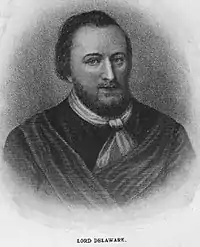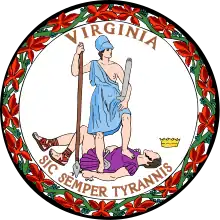Thomas West, 3rd Baron De La Warr
Thomas West, 3rd Baron De La Warr (/ˈdɛləwɛər/ (![]() listen) DEL-ə-wair;[1][2][3] 9 July 1577 – 7 June 1618) was an English politician, for whom the bay, the river, and, consequently, a Native American people and U.S. state, all later called "Delaware", were named.
listen) DEL-ə-wair;[1][2][3] 9 July 1577 – 7 June 1618) was an English politician, for whom the bay, the river, and, consequently, a Native American people and U.S. state, all later called "Delaware", were named.


There have been two creations of Baron De La Warr, and West came from the second. He was the son of Thomas West, 2nd Baron De La Warr, of Wherwell Abbey in Hampshire and Anne Knollys, daughter of Catherine Carey, Lady Knollys; making him a great-grandson of Mary Boleyn. He was born at Wherwell, Hampshire, England, and died at sea while travelling from England to the Colony of Virginia. Counting from the original creation of the title, West would be the 12th Baron.[4]
Biography
Thomas West received his education at Queen's College, Oxford. He served in the English army under Robert Devereux, 2nd Earl of Essex, and, in 1601, was charged with supporting Essex's ill-fated insurrection against Queen Elizabeth I, but he was acquitted of those charges.[5] He succeeded his father as Baron De La Warr in 1602.[6] It was said that he became a member of the Privy Council, but this has been disproved.[7]
Lord De La Warr was appointed governor-for-life and captain-general of the Colony of Virginia, to replace the governing council of the colony under the presidency of Captain John Smith.[8] Subsequently, in November 1609, the Powhatan tribe of Native Americans killed John Ratcliffe, the Jamestown Colony's Council President, and attacked the colony in what became the First Anglo-Powhatan War.[9] As part of England's response, De La Warr recruited and equipped a contingent of 150 men and outfitted three ships at his own expense, and sailed from England in March 1610.[10]
Lord De La Warr returned to England due to illness in the spring of 1611, leaving his deputy, Sir Samuel Argall, in charge of the colony. Later that year, De La Warr published a book titled The Relation of the Right Honourable the Lord De-La-Warre, Lord Governour and Captaine Generall of the Colonie, planted in Virginea.[11] Although attributed to De La Warr, the book was actually written by company employee Samuel Calvert.[7] De La Warr remained the nominal governor, and after receiving complaints from the Virginia settlers about Argall's tyranny in governing them on his behalf, he set sail for Virginia again in 1618 aboard the Neptune to investigate those charges. He died at sea on 7 June[5][12] and it is believed that he was poisoned.[7]
It was thought for many years that Lord De La Warr had been buried in the Azores or at sea.[5] By 2006, researchers had concluded that his body was brought to Jamestown for burial. In October 2017, archaeologists excavated remains from underneath one of the churches at Historic Jamestowne, but it is not yet known if De La Warr's is one of those.[13]
Lord De La Warr's brother, John West, later became governor of Virginia, and married Anne Percy, daughter of George Percy.[14]
Family
On 25 November 1596, De La Warr married Cecily (died c. 1662), the daughter of Sir Thomas Shirley of Wiston, Sussex and Anne, daughter of Sir Thomas Kempe.[15] They had children:
- Cecily or Cecilia (died February 1638), who married firstly Sir Francis Bindlosse and secondly after 1629 John Byron, 1st Baron Byron. She was buried at Hucknall-Torkard in Nottinghamshire.[16]
- Lucy, who married Sir Robert Byron (d. after 1643), Governor of Liverpool and a Colonel in the service of the Royalist Infantry Forces who fought in the English Civil War.[17]
- Robert, who married Elizabeth Coch.[18]
- Henry (1603–1628), who succeeded his father as the 4th Baron De La Warr, married Isabella, daughter of Sir Thomas Edmondes, in March 1625. He died at the age of 24 and was succeeded by his son Charles West, 5th Baron De La Warr.[19]
- Martha (1615–1700), who married William Woodward. Their daughter Martha Woodward married Gideon Macon. After Gideon's death Martha married Captain Nathaniel West her first cousin, once removed.[20]
Notes
- Németh, Robert Stuart (13 September 2006). "The De La Warr Pavilion". Building Opinions. Latest Homes. Archived from the original on 13 July 2013.
- Billings, Warren M. "Thomas West, Twelfth Baron De La Warr (1576–1618)". Dictionary of Virginia Biography. Encyclopedia Virginia. Retrieved 23 March 2015.
- "Delaware Place Names" (PDF) (Report). United States Geological Survey.
- Thomas West, 12th Baron De La Warr at the Encyclopædia Britannica
- Pollard, Albert Frederick (1899). . In Lee, Sidney (ed.). Dictionary of National Biography. 60. London: Smith, Elder & Co. pp. 344–45.
- Fiske, John (1897). Old Virginia and Her Neighbours. 1. Boston and New York: Houghton, Mifflin and Company. pp. 146–47.
- Rose, E.M. (2020). "Lord Delaware, First Governor of Virginia, 'the Poorest Baron of this Kingdom'". Virginia: Virginia Magazine of History 128.3. pp. 226–258. JSTOR 26926494.
- "The Jamestown Chronicles Timeline", 12 May 2016
- Lamont, Edward M. (2014). The Forty Years that Created America: The Story of the Explorers, Promoters, Investors, and Settlers Who Founded the First English Colonies. Rowman & Littlefield. p. 121. ISBN 978-1442236608.
- Brown, Alexander (1898). The First Republic in America. New York: Houghton, Mifflin. p. 126.
- De La Warr, Thomas West, Baron (1611). The Relation of the Right Honourable the Lord De-La-Warre, Lord Governour and Captaine Generall of the Colonie, planted in Virginea at Archive.org.
- "Virginia Encyclopedia".
- Ruane, Michael E. (27 October 2017). "Experts have uncovered remains at the first permanent English colony. But whose bones are they?". The Washington Post. Retrieved 22 May 2019.
- Bradburn, Douglas; Coombs, John C. (2011). Early Modern Virginia: Reconsidering the Old Dominion. University of Virginia Press. p. 50. ISBN 978-0813931708.
- Cokayne 2000, p. 161
- Cokayne 1983, p. 140, Hammond 1998, p. 128, Mosley 2003, p. 630.
- Mosley 2003, pp. 630, 1075.
- Mosley 2003, p. 1075
- Cokayne 2000, p. 161, Mosley 2003, p. 1075.
- "Martha West". www.geneall.net. Retrieved 28 December 2013.
References
- Cokayne, George Edward, ed. (1983) [c. 1900]. The Complete Baronetage. 2 (5-volume reprint ed.). Gloucester, UK: Alan Sutton Publishing. p. 140.
- Cokayne, George Edward; et al., eds. (2000) [1910–1959]. The Complete Peerage of England, Scotland, Ireland, Great Britain and the United Kingdom, Extant, Extinct or Dormant. 4 (reprint in 6 volumes; new ed.). Gloucester, UK: Alan Sutton Publishing. p. 160.
- Mosley, Charles, ed. (2003). Burke's Peerage, Baronetage & Knightage. 1 (107th ed.). Wilmington, DE: Burke's Peerage (Genealogical Books). pp. 630, 1075.
- Hammond, Peter W., ed. (1998). The Complete Peerage or a History of the House of Lords and All its Members From the Earliest Times, Volume XIV: Addenda & Corrigenda. Stroud, Gloucestershire, UK: Sutton Publishing. p. 128.
External links
| Peerage of England | ||
|---|---|---|
| Preceded by Thomas West |
Baron De La Warr 1602–1618 |
Succeeded by Henry West |
| Government offices | ||
| Preceded by Thomas Gates |
Colonial Governor of Virginia 1610–1611 |
Succeeded by George Percy |
